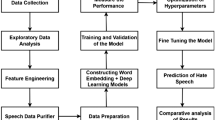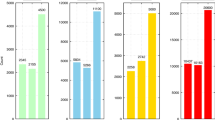Abstract
Social media have been growing rapidly during past years. They changed different aspects of human life, especially how people communicate and also how people access information. However, along with the important benefits, social media causes a number of significant challenges since they were introduced. Spreading of fake news and hate speech are among the most challenging issues which have attracted a lot of attention by researchers in past years. Different models based on natural language processing are developed to combat these phenomena and stop them in the early stages before mass spreading. Considering the difficulty of the task of automated harmful information detection (i.e., fake news and hate speech detection), every single step of the detection process could have a sensible impact on the performance of models. In this paper, we study the importance of word embedding on the overall performance of deep neural network architecture on the detection of fake news and hate speech on social media. We test various approaches for converting raw input text into vectors, from random weighting to state-of-the-art contextual word embedding models. In addition, to compare different word embedding approaches, we also analyze different strategies to get the vectors from contextual word embedding models (i.e., get the weights from the last layer, against averaging weights of the last layers). Our results show that XLNet embedding outperforms the other embedding approaches on both tasks related to harmful information identification.
Access this chapter
Tax calculation will be finalised at checkout
Purchases are for personal use only
Similar content being viewed by others
References
Asghari, H., Fatemi, O., Mohtaj, S., Faili, H., Rosso, P.: On the use of word embedding for cross language plagiarism detection. Intell. Data Anal. 23(3), 661–680 (2019). https://doi.org/10.3233/IDA-183985
Bojanowski, P., Grave, E., Joulin, A., Mikolov, T.: Enriching word vectors with subword information. Trans. Assoc. Comput. Linguist. 5, 135–146 (2017). https://transacl.org/ojs/index.php/tacl/article/view/999
Cho, K., van Merrienboer, B., Bahdanau, D., Bengio, Y.: On the properties of neural machine translation: Encoder-decoder approaches. In: Wu, D., Carpuat, M., Carreras, X., Vecchi, E.M. (eds.) Proceedings of SSST@EMNLP 2014, Eighth Workshop on Syntax, Semantics and Structure in Statistical Translation, Doha, Qatar, 25 October 2014, pp. 103–111. Association for Computational Linguistics (2014)
Demartini, G., Mizzaro, S., Spina, D.: Human-in-the-loop artificial intelligence for fighting online misinformation: challenges and opportunities. IEEE Data Eng. Bull. 43(3), 65–74 (2020)
Devlin, J., Chang, M., Lee, K., Toutanova, K.: BERT: pre-training of deep bidirectional transformers for language understanding. In: Burstein, J., Doran, C., Solorio, T. (eds.) Proceedings of the 2019 Conference of the North American Chapter of the Association for Computational Linguistics: Human Language Technologies, NAACL-HLT 2019, Minneapolis, MN, USA, 2–7 June 2019, Volume 1 (Long and Short Papers), pp. 4171–4186. Association for Computational Linguistics (2019). https://doi.org/10.18653/v1/n19-1423
Ethayarajh, K.: How contextual are contextualized word representations? comparing the geometry of BERT, ELMO, and GPT-2 embeddings. In: Inui, K., Jiang, J., Ng, V., Wan, X. (eds.) Proceedings of the 2019 Conference on Empirical Methods in Natural Language Processing and the 9th International Joint Conference on Natural Language Processing, EMNLP-IJCNLP 2019, Hong Kong, China, 3–7 November 2019, pp. 55–65. Association for Computational Linguistics (2019). https://doi.org/10.18653/v1/D19-1006
Frenda, S., Ghanem, B., Montes-y-Gómez, M., Rosso, P.: Online hate speech against women: automatic identification of misogyny and sexism on twitter. J. Intell. Fuzzy Syst. 36(5), 4743–4752 (2019). https://doi.org/10.3233/JIFS-179023
Ghanem, B., Ponzetto, S.P., Rosso, P., Rangel, F.: Fakeflow: fake news detection by modeling the flow of affective information. In: Merlo, P., Tiedemann, J., Tsarfaty, R. (eds.) Proceedings of the 16th Conference of the European Chapter of the Association for Computational Linguistics: Main Volume, EACL 2021, Online, 19–23 April 2021, pp. 679–689. Association for Computational Linguistics (2021). https://doi.org/10.18653/v1/2021.eacl-main.56
Giachanou, A., Rosso, P.: The battle against online harmful information: the cases of fake news and hate speech. In: d’Aquin, M., Dietze, S., Hauff, C., Curry, E., Cudré-Mauroux, P. (eds.) CIKM 2020: The 29th ACM International Conference on Information and Knowledge Management, Virtual Event, Ireland, 19–23 October 2020, pp. 3503–3504. ACM (2020). https://doi.org/10.1145/3340531.3412169
Gitari, N.D., Zhang, Z., Damien, H., Long, J.: A lexicon-based approach for hate speech detection. Int. J. Multimedia Ubiquit. Eng. 10(4), 215–230 (2015). https://doi.org/10.14257/ijmue.2015.10.4.21
Haber, J., Poesio, M.: Word sense distance in human similarity judgements and contextualised word embeddings. In: Proceedings of the Probability and Meaning Conference (PaM 2020), pp. 128–145. Association for Computational Linguistics, Gothenburg, June 2020. https://aclanthology.org/2020.pam-1.17
Hu, L., et al.: Compare to the knowledge: graph neural fake news detection with external knowledge. In: Zong, C., Xia, F., Li, W., Navigli, R. (eds.) Proceedings of the 59th Annual Meeting of the Association for Computational Linguistics and the 11th International Joint Conference on Natural Language Processing, ACL/IJCNLP 2021, (Volume 1: Long Papers), Virtual Event, 1–6 August 2021, pp. 754–763. Association for Computational Linguistics (2021). https://doi.org/10.18653/v1/2021.acl-long.62
Jain, M., Goel, P., Singla, P., Tehlan, R.: Comparison of various word embeddings for hate-speech detection. In: Khanna, A., Gupta, D., Pólkowski, Z., Bhattacharyya, S., Castillo, O. (eds.) Data Analytics and Management. LNDECT, vol. 54, pp. 251–265. Springer, Singapore (2021). https://doi.org/10.1007/978-981-15-8335-3_21
Jhaver, S., Birman, I., Gilbert, E., Bruckman, A.S.: Human-machine collaboration for content regulation: the case of reddit automoderator. ACM Trans. Comput. Hum. Interact. 26(5), 31:1–31:35 (2019). https://doi.org/10.1145/3338243
Liu, Y., et al.: RoBERTa: a robustly optimized BERT pretraining approach. CoRR abs/1907.11692 (2019). https://arxiv.org/abs/1907.11692
Modha, S., et al.: Overview of the HASOC subtrack at FIRE 2021: hate speech and offensive content identification in English and Indo-Aryan languages and conversational hate speech. In: Ganguly, D., Gangopadhyay, S., Mitra, M., Majumder, P. (eds.) FIRE 2021: Forum for Information Retrieval Evaluation, Virtual Event, India, 13–17 December 2021, pp. 1–3. ACM (2021). https://doi.org/10.1145/3503162.3503176
Mohtaj, S., Schmitt, V., Möller, S.: A feature extraction based model for hate speech identification. CoRR abs/2201.04227 (2022). https://arxiv.org/abs/2201.04227
Mohtaj, S., Woloszyn, V., Möller, S.: TUB at HASOC 2020: character based LSTM for hate speech detection in Indo-European languages. In: Mehta, P., Mandl, T., Majumder, P., Mitra, M. (eds.) Working Notes of FIRE 2020 - Forum for Information Retrieval Evaluation, Hyderabad, India, 16–20 December 2020. CEUR Workshop Proceedings, vol. 2826, pp. 298–303. CEUR-WS.org (2020). https://ceur-ws.org/Vol-2826/T2-26.pdf
Pan, J.Z., Pavlova, S., Li, C., Li, N., Li, Y., Liu, J.: Content based fake news detection using knowledge graphs. In: Vrandečić, D., et al. (eds.) ISWC 2018. LNCS, vol. 11136, pp. 669–683. Springer, Cham (2018). https://doi.org/10.1007/978-3-030-00671-6_39
Patwa, P., et al.: Fighting an infodemic: COVID-19 fake news dataset. In: Chakraborty, T., Shu, K., Bernard, H.R., Liu, H., Akhtar, M.S. (eds.) CONSTRAINT 2021. CCIS, vol. 1402, pp. 21–29. Springer, Cham (2021). https://doi.org/10.1007/978-3-030-73696-5_3
Pennington, J., Socher, R., Manning, C.D.: Glove: global vectors for word representation. In: Moschitti, A., Pang, B., Daelemans, W. (eds.) Proceedings of the 2014 Conference on Empirical Methods in Natural Language Processing, EMNLP 2014, 25–29 October 2014, Doha, Qatar, A meeting of SIGDAT, a Special Interest Group of the ACL, pp. 1532–1543. ACL (2014). https://doi.org/10.3115/v1/d14-1162
Peters, M.E., et al.: Deep contextualized word representations. In: Walker, M.A., Ji, H., Stent, A. (eds.) Proceedings of the 2018 Conference of the North American Chapter of the Association for Computational Linguistics: Human Language Technologies, NAACL-HLT 2018, New Orleans, Louisiana, USA, 1–6 June 2018, Volume 1 (Long Papers), pp. 2227–2237. Association for Computational Linguistics (2018). https://doi.org/10.18653/v1/n18-1202
Radford, A., Wu, J., Child, R., Luan, D., Amodei, D., Sutskever, I.: Language models are unsupervised multitask learners (2019)
Sharma, D.K., Garg, S.: IFND: a benchmark dataset for fake news detection. Complex Intell. Syst. 1–21 (2021)
Shu, K., Mahudeswaran, D., Liu, H.: FakeNewsTracker: a tool for fake news collection, detection, and visualization. Comput. Math. Organ. Theory 25(1), 60–71 (2018). https://doi.org/10.1007/s10588-018-09280-3
Verma, P.K., Agrawal, P., Amorim, I., Prodan, R.: Welfake: word embedding over linguistic features for fake news detection. IEEE Trans. Comput. Soc. Syst. 8(4), 881–893 (2021)
Wolf, T., et al.: Transformers: state-of-the-art natural language processing. In: Liu, Q., Schlangen, D. (eds.) Proceedings of the 2020 Conference on Empirical Methods in Natural Language Processing: System Demonstrations, EMNLP 2020 - Demos, Online, 16–20 November 2020, pp. 38–45. Association for Computational Linguistics (2020)
Yang, Z., Dai, Z., Yang, Y., Carbonell, J.G., Salakhutdinov, R., Le, Q.V.: XLNET: generalized autoregressive pretraining for language understanding. In: Wallach, H.M., Larochelle, H., Beygelzimer, A., d’Alché-Buc, F., Fox, E.B., Garnett, R. (eds.) Advances in Neural Information Processing Systems 32: Annual Conference on Neural Information Processing Systems 2019, NeurIPS 2019, 8–14 December 2019, Vancouver, BC, Canada, pp. 5754–5764 (2019). https://proceedings.neurips.cc/paper/2019/hash/dc6a7e655d7e5840e66733e9ee67cc69-Abstract.html
Zhang, X., Ghorbani, A.A.: An overview of online fake news: characterization, detection, and discussion. Inf. Process. Manag. 57(2), 102025 (2020). https://doi.org/10.1016/j.ipm.2019.03.004
Zulqarnain, M., Ghazali, R., Hassim, Y.M.M., Rehan, M.: A comparative review on deep learning models for text classification. Indonesian J. Electr. Eng. Comput. Sci. 19(1), 325–335 (2020)
Acknowledgment
This research was funded in part by the German Federal Ministry of Education and Research (BMBF) under grant number 01IS17043 (project ILSFAS).
Author information
Authors and Affiliations
Corresponding author
Editor information
Editors and Affiliations
Rights and permissions
Copyright information
© 2022 Springer Nature Switzerland AG
About this paper
Cite this paper
Mohtaj, S., Möller, S. (2022). On the Importance of Word Embedding in Automated Harmful Information Detection. In: Sojka, P., Horák, A., Kopeček, I., Pala, K. (eds) Text, Speech, and Dialogue. TSD 2022. Lecture Notes in Computer Science(), vol 13502. Springer, Cham. https://doi.org/10.1007/978-3-031-16270-1_21
Download citation
DOI: https://doi.org/10.1007/978-3-031-16270-1_21
Published:
Publisher Name: Springer, Cham
Print ISBN: 978-3-031-16269-5
Online ISBN: 978-3-031-16270-1
eBook Packages: Computer ScienceComputer Science (R0)




